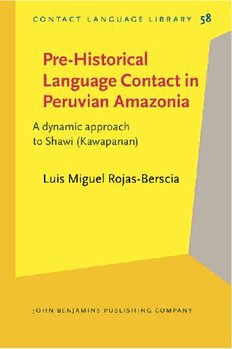
Pre-Historical Language Contact in Peruvian Amazonia: A dynamic approach to Shawi (Kawapanan) PDF
Preview Pre-Historical Language Contact in Peruvian Amazonia: A dynamic approach to Shawi (Kawapanan)
Pre-Historical Language Contact in Peruvian Amazonia Contact Language Library (CoLL) issn 2542-7059 Contact Language Library (CoLL), formerly Creole Language Library, presents descriptive and theoretical studies on contact languages, such as pidgin and creole languages, mixed languages and other languages which have undergone significant contact-induced change. All CoLL publications are anonymously and internationally refereed. For an overview of all books published in these series, please see benjamins.com/catalog/cll and benjamins.com/catalog/coll Editors Founding Editor Felicity Meakins Viveka Velupillai Pieter Muysken University of Queensland Justus Liebig University Giessen Australia Germany Editorial Advisory Board Umberto Ansaldo Silvia Kouwenberg Shobha Satyanath Hong Kong SAR, China Kingston, Jamaica Delhi, India Peter Bakker Michelle Li Armin Schwegler Aarhus, Denmark Hong Kong SAR, China Irvine, USA Marlyse Baptista Miriam Meyerhoff Sarah G. Thomason Ann Arbor, USA Wellington, New Zealand Ann Arbor, USA Joseph T. Farquharson Susanne Maria Michaelis Tonjes Veenstra Kingston, Jamaica Leipzig, Germany Berlin, Germany Diana Guillemin Salikoko S. Mufwene Brisbane, Australia Chicago, USA Volume 58 Pre-Historical Language Contact in Peruvian Amazonia A dynamic approach to Shawi (Kawapanan) by Luis Miguel Rojas-Berscia Pre-Historical Language Contact in Peruvian Amazonia A dynamic approach to Shawi (Kawapanan) Luis Miguel Rojas-Berscia University of Queensland John Benjamins Publishing Company Amsterdam / Philadelphia TM The paper used in this publication meets the minimum requirements of 8 the American National Standard for Information Sciences – Permanence of Paper for Printed Library Materials, ansi z39.48-1984. doi 10.1075/coll.58 Cataloging-in-Publication Data available from Library of Congress: lccn 2020050371 (print) / 2020050372 (e-book) isbn 978 90 272 0836 1 (Hb) isbn 978 90 272 6021 5 (e-book) © 2021 – John Benjamins B.V. No part of this book may be reproduced in any form, by print, photoprint, microfilm, or any other means, without written permission from the publisher. John Benjamins Publishing Company · https://benjamins.com Para mi Mamá Mila, madre, compañera, amiga y maestra lenguaraz, póstumamente Table of contents List of Figures xi List of Tables xiii Acknowledgments xvii 1. Introduction 1 1.1 The South American paradox 1 1.2 Theoretical considerations: From trees to waves and the emergence of a speaker-centred approach 6 1.2.1 The emergence of the family tree model 6 1.2.2 Wave Theory and the speaker-centred approach 10 1.3 The glossography of power 13 1.4 Polylectal Internally Dynamic Competence: Towards a Flux approach 17 1.4.1 The rebirth of the Wave approach within Generative Semantics 18 1.4.2 A Flux approach, a first sketch 22 1.5 The present study 24 1.5.1 Main research questions 24 1.5.2 Structure of the book 25 2. The Shawi community 27 2.1 Introduction 27 2.2 The prehistorical Kawapanan area 29 2.3 The Jesuit Missions and the colonial society 31 2.4 Modern Shawi society 38 2.5 The impact of modern Western society 40 3. A short gramar of Shawi 43 3.1 Introduction 43 3.1.1 Structure 44 3.2 Languages, language varieties and speaker profiles 45 3.2.1 Dialectology and “family tree” structure 46 3.2.2 Glottonyms 47 3.3 Grammatical profile 48 viii Pre-Historical Language Contact in Peruvian Amazonia 3.4 Phonology 52 3.4.1 Phonemes 52 3.4.2 Syllable structure 57 3.4.3 Processes 58 3.5 Orthography 60 3.6 Open word classes 62 3.6.1 Nouns 62 3.6.2 Verbs 73 3.7 Closed word classes 90 3.7.1 Adjectives 90 3.7.2 Pronouns 91 3.7.3 Deictics 92 3.7.4 Numerals 92 3.7.5 Adverbs 95 3.7.6 Conjunctions 97 3.7.7 Interjections 98 3.8 Major morpho-syntactic processes 99 3.8.1 Valency changing operations 99 3.8.2 Nominalisation 110 3.8.3 Grammatical relations and alignment 121 3.8.4 Discourse elements 130 4 From Proto-Kawapanan to Shawi 133 4.1 Introduction 133 4.2 A reconsideration of the proposal in Valenzuela Bismarck (2011) 134 4.3 Rhyme correspondences 139 4.3.1 Current proposal 139 4.4 Some historical phonological processes in Shawi 149 4.4.1 Shawi ablaut 149 4.4.2 Glide amalgamation in Shawi 152 4.4.3 Dispreference for word-initial in Shawi 153 4.4.4 Palatalisation in Shawi 153 ɘ 4.4.5 Initial a- before vowels in Shawi 154 4.5 Further discussion 155 5 The history of Kawapanan pronouns, a first Bayesian phylogenetic analysis 159 5.1 Introduction 159 5.2 Using phoneme-level data in phylogenetic reconstructions 163 5.2.1 Limitations of the method 166 5.3 Methods 167 5.3.1 Data 167 Table of contents ix 5.3.2 Cognate coding and alignment 167 5.3.3 Bayesian phylogenetic analysis 170 5.4 Results 171 5.4.1 Examples 173 5.5 Discussion 174 5.5.1 The Kawapanan-Puelche hypothesis and beyond 174 5.6 Discussion 179 6 Kawapanan in its geographical context1 181 6.1 Introduction 181 6.2 The Farming-Agricultural Flux, the Chavín type? 186 6.2.1 The Andean non-future and Subject Raising 188 6.2.2 Some other features 190 6.3 Further uphill, the Carib and Chachapuya elements in Kawapanan 191 6.4 The Arawak trade route Flux 197 6.4.1 The Arawak Matrix 197 6.4.2 The Arawak lexicon in Kawapanan 198 6.4.3 Predicate Raising and branching directionality change 202 6.4.4 The alienable/inalienable distinction 206 6.5 The Jivaroan wars Flux 206 6.6 Final ideas 209 7 The Marañón-Huallaga exchange route 211 7.1 Introduction 211 7.2 Linguistic survey 212 7.3 Classifiers in the area 214 7.3.1 Hibito-Cholón 214 7.3.2 Kawapanan 217 7.3.3 Muniche 220 7.3.4 Quingnam 221 7.4 Stones and grains as counting devices 223 7.5 Sociohistorical scenario: The salt mines of Cachiyacu 228 7.6 Final ideas 231 8 Shawi disassembled 233 8.1 From the first settlement to the consolidation of Shawi vernaculars 234 8.2 A timeline of Fluxes for the linguistic history of Kawapanan 236 8.3 Avenues of future research 238 References 241 Index 259
